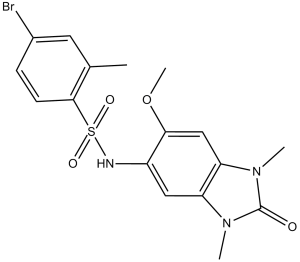
| 规格 | 价格 | 库存 | 数量 |
|---|---|---|---|
| 10 mM * 1 mL in DMSO |
|
||
| 1mg |
|
||
| 5mg |
|
||
| 10mg |
|
||
| 25mg |
|
||
| 50mg |
|
||
| 100mg |
|
||
| 250mg |
|
||
| 500mg |
|
||
| Other Sizes |
|
| 体外研究 (In Vitro) |
OF-1(1 μM 和 2 μM,0、1、2 和 3 天)可诱导多核抗酒石酸酸性磷酸酶 (TRAP) 阳性细胞数量显着减少[1]。 OF-1 是完全抑制多核“破骨细胞样”细胞融合的唯一抑制剂[1]。
|
||
|---|---|---|---|
| 细胞实验 |
细胞活力测定[1]
细胞类型:使用 10 ng/mL RANKL 分化期间的小鼠 BMC。 测试浓度:1 μM 和 2 μM。 孵化持续时间:0、1、2 和 3 天。 实验结果: RANKL 诱导分化后第 2 天特别强。 |
||
| 动物实验 |
|
||
| 参考文献 |
| 分子式 |
C17H18BRN3O4S
|
|
|---|---|---|
| 分子量 |
440.31
|
|
| 精确质量 |
439.02
|
|
| CAS号 |
919973-83-4
|
|
| 相关CAS号 |
|
|
| PubChem CID |
35397514
|
|
| 外观&性状 |
White to off-white solid powder
|
|
| 密度 |
1.6±0.1 g/cm3
|
|
| 沸点 |
573.8±60.0 °C at 760 mmHg
|
|
| 闪点 |
300.8±32.9 °C
|
|
| 蒸汽压 |
0.0±1.6 mmHg at 25°C
|
|
| 折射率 |
1.644
|
|
| LogP |
3.32
|
|
| tPSA |
90.71
|
|
| 氢键供体(HBD)数目 |
1
|
|
| 氢键受体(HBA)数目 |
5
|
|
| 可旋转键数目(RBC) |
4
|
|
| 重原子数目 |
26
|
|
| 分子复杂度/Complexity |
640
|
|
| 定义原子立体中心数目 |
0
|
|
| InChi Key |
YUNQZQREIHWDQT-UHFFFAOYSA-N
|
|
| InChi Code |
InChI=1S/C17H18BrN3O4S/c1-10-7-11(18)5-6-16(10)26(23,24)19-12-8-13-14(9-15(12)25-4)21(3)17(22)20(13)2/h5-9,19H,1-4H3
|
|
| 化学名 |
4-Bromo-N-(6-methoxy-1,3-dimethyl-2-oxo-2,3-dihydro-1H-benzoimidazol-5-yl)-2-methyl-benzenesulfonamide
|
|
| 别名 |
|
|
| HS Tariff Code |
2934.99.9001
|
|
| 存储方式 |
Powder -20°C 3 years 4°C 2 years In solvent -80°C 6 months -20°C 1 month |
|
| 运输条件 |
Room temperature (This product is stable at ambient temperature for a few days during ordinary shipping and time spent in Customs)
|
| 溶解度 (体外实验) |
|
|||
|---|---|---|---|---|
| 溶解度 (体内实验) |
配方 1 中的溶解度: ≥ 2.5 mg/mL (5.68 mM) (饱和度未知) in 10% DMSO + 40% PEG300 + 5% Tween80 + 45% Saline (这些助溶剂从左到右依次添加,逐一添加), 澄清溶液。
例如,若需制备1 mL的工作液,可将100 μL 25.0 mg/mL澄清DMSO储备液加入到400 μL PEG300中,混匀;然后向上述溶液中加入50 μL Tween-80,混匀;加入450 μL生理盐水定容至1 mL。 *生理盐水的制备:将 0.9 g 氯化钠溶解在 100 mL ddH₂O中,得到澄清溶液。 配方 2 中的溶解度: ≥ 2.5 mg/mL (5.68 mM) (饱和度未知) in 10% DMSO + 90% Corn Oil (这些助溶剂从左到右依次添加,逐一添加), 澄清溶液。 例如,若需制备1 mL的工作液,可将 100 μL 25.0 mg/mL 澄清 DMSO 储备液加入到 900 μL 玉米油中并混合均匀。 请根据您的实验动物和给药方式选择适当的溶解配方/方案: 1、请先配制澄清的储备液(如:用DMSO配置50 或 100 mg/mL母液(储备液)); 2、取适量母液,按从左到右的顺序依次添加助溶剂,澄清后再加入下一助溶剂。以 下列配方为例说明 (注意此配方只用于说明,并不一定代表此产品 的实际溶解配方): 10% DMSO → 40% PEG300 → 5% Tween-80 → 45% ddH2O (或 saline); 假设最终工作液的体积为 1 mL, 浓度为5 mg/mL: 取 100 μL 50 mg/mL 的澄清 DMSO 储备液加到 400 μL PEG300 中,混合均匀/澄清;向上述体系中加入50 μL Tween-80,混合均匀/澄清;然后继续加入450 μL ddH2O (或 saline)定容至 1 mL; 3、溶剂前显示的百分比是指该溶剂在最终溶液/工作液中的体积所占比例; 4、 如产品在配制过程中出现沉淀/析出,可通过加热(≤50℃)或超声的方式助溶; 5、为保证最佳实验结果,工作液请现配现用! 6、如不确定怎么将母液配置成体内动物实验的工作液,请查看说明书或联系我们; 7、 以上所有助溶剂都可在 Invivochem.cn网站购买。 |
| 制备储备液 | 1 mg | 5 mg | 10 mg | |
| 1 mM | 2.2711 mL | 11.3556 mL | 22.7113 mL | |
| 5 mM | 0.4542 mL | 2.2711 mL | 4.5423 mL | |
| 10 mM | 0.2271 mL | 1.1356 mL | 2.2711 mL |
1、根据实验需要选择合适的溶剂配制储备液 (母液):对于大多数产品,InvivoChem推荐用DMSO配置母液 (比如:5、10、20mM或者10、20、50 mg/mL浓度),个别水溶性高的产品可直接溶于水。产品在DMSO 、水或其他溶剂中的具体溶解度详见上”溶解度 (体外)”部分;
2、如果您找不到您想要的溶解度信息,或者很难将产品溶解在溶液中,请联系我们;
3、建议使用下列计算器进行相关计算(摩尔浓度计算器、稀释计算器、分子量计算器、重组计算器等);
4、母液配好之后,将其分装到常规用量,并储存在-20°C或-80°C,尽量减少反复冻融循环。
计算结果:
工作液浓度: mg/mL;
DMSO母液配制方法: mg 药物溶于 μL DMSO溶液(母液浓度 mg/mL)。如该浓度超过该批次药物DMSO溶解度,请首先与我们联系。
体内配方配制方法:取 μL DMSO母液,加入 μL PEG300,混匀澄清后加入μL Tween 80,混匀澄清后加入 μL ddH2O,混匀澄清。
(1) 请确保溶液澄清之后,再加入下一种溶剂 (助溶剂) 。可利用涡旋、超声或水浴加热等方法助溶;
(2) 一定要按顺序加入溶剂 (助溶剂) 。
| NCT Number | Recruitment | interventions | Conditions | Sponsor/Collaborators | Start Date | Phases |
| NCT04591171 | Completed Has Results | Procedure: n-of-1 trial guided clinical decision making |
Hypertension Chronic Kidney Diseases |
The University of Texas Health Science Center, Houston |
January 25, 2021 | Not Applicable |
| NCT02744456 | Completed | Drug: Amlodipine Drug: Hydrochlorothiazide |
Hypertension High Blood Pressure |
Columbia University | August 1, 2014 | Early Phase 1 |
| NCT00299169 | Terminated | Behavioral: N of 1 Trials | Diabetes Cardiovascular Disease |
Lawson Health Research Institute | September 2006 | Phase 4 |
| NCT04757584 | Completed Has Results | Drug: Beta blockers | Heart Failure Heart Failure, Diastolic |
Weill Medical College of Cornell University |
April 1, 2021 | Phase 4 |
|
|
|